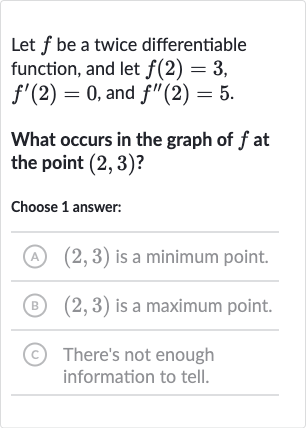Full solution
Q. Let be a twice differentiable function, and let , , and .What occurs in the graph of at the point ?Choose answer:(A) is a minimum point.(B) is a maximum point.(C) There's not enough information to tell.
- Given Information: We are given that is a twice differentiable function, which means it is smooth and has a continuous first and second derivative. We are also given that , , and . The value tells us that the point lies on the graph of . The value indicates that the slope of the tangent to the graph of at is zero, which means the graph has a horizontal tangent line at this point. This could be indicative of a local maximum, local minimum, or a point of inflection.
- Analysis of : To determine whether is a maximum, minimum, or neither, we need to consider the second derivative, . The value is positive, which tells us that the concavity of the graph at is upwards (like a smile). According to the second derivative test, if the first derivative at a point is zero and the second derivative at that point is positive, then the function has a local minimum at that point.
- Second Derivative Test: Since and f''(2) > 0, we can conclude that is a local minimum point on the graph of . This answers the question prompt.
More problems from One-step inequalities: word problems
QuestionGet tutor help
QuestionGet tutor help
QuestionGet tutor help
QuestionGet tutor help
QuestionGet tutor help
QuestionGet tutor help
QuestionGet tutor help
QuestionGet tutor help
QuestionGet tutor help
QuestionGet tutor help

